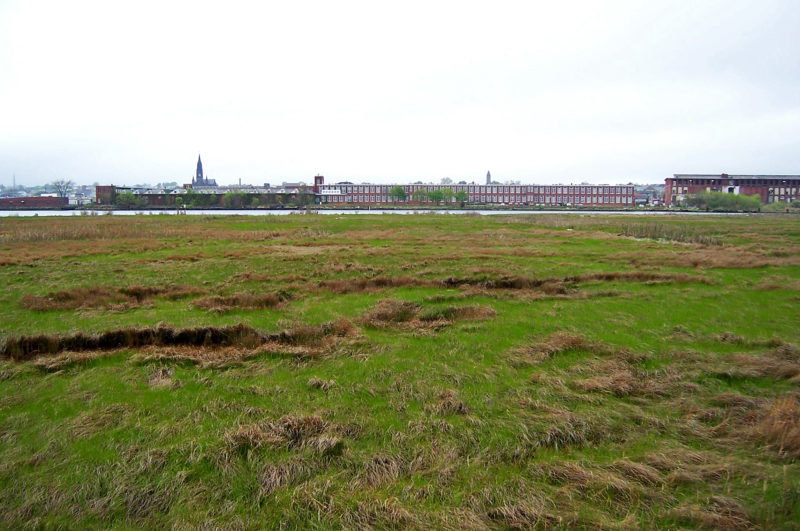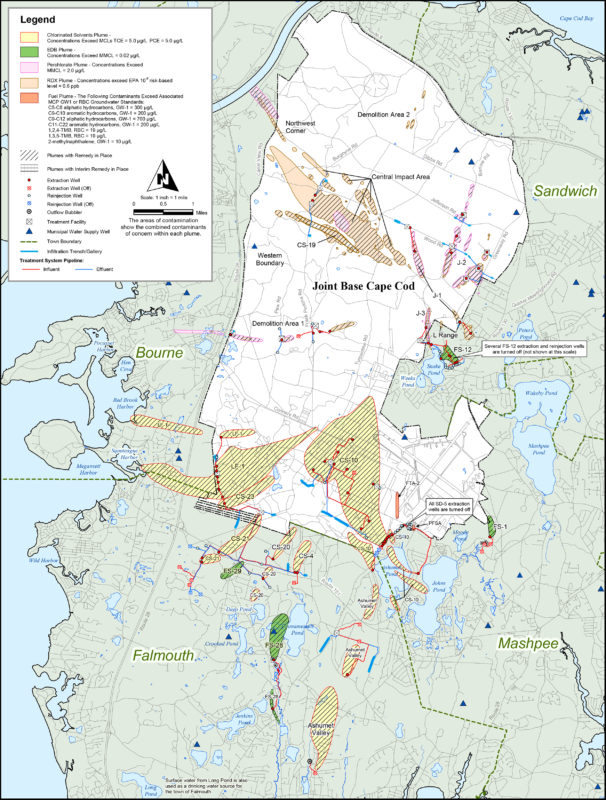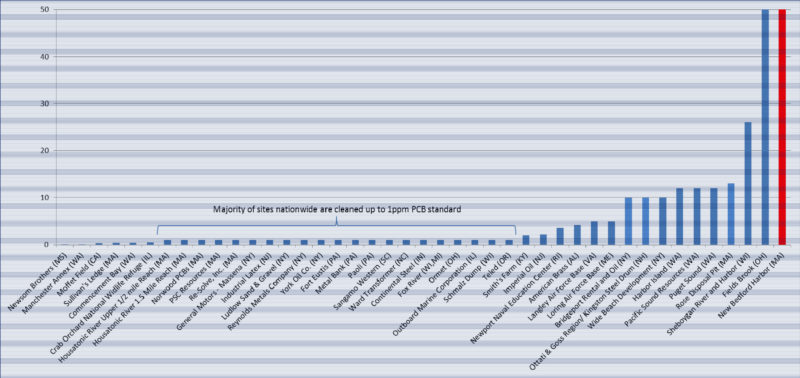Since he moved to the shores of the Acushnet River a few years ago, Bradie Metheny has fallen in love with the river. Every morning, he watches ducks and swans swim as the sun rises over the water’s tranquil surface. Despite legacy toxic pollution that lingers in the river bottom, the waterway is a haven for local residents like Metheny – and with a proper cleanup, it can be the same for those who want to fish and shellfish along its shores.
Among all of the pollution threats to Buzzards Bay, toxic contamination has seen the greatest reductions in the past several decades. But toxic pollution is still a problem in parts of the Bay, particularly where old legacy contaminants remain. Through strong, dedicated advocacy, the Coalition is working to make toxic pollution a relic of the past.
Where does toxic pollution come from?
Thanks to stricter laws and better enforcement, toxic pollution in Buzzards Bay is continuing to decrease. But in certain places around the Bay, toxic contamination still presents a problem for both people and marine life.
There are two general sources of toxic pollution in Buzzards Bay. Legacy toxic pollution lingers at places like New Bedford Harbor and the former Massachusetts Military Reservation on Cape Cod. But each day, people contribute new sources of toxic pollution from their homes and lawns.
Legacy toxic pollution in New Bedford Harbor

Factories along the Acushnet River dumped toxic PCBs into the water in the middle of the 20th century. Toxic contaminants still linger at the bottom of the river and New Bedford Harbor, just downstream from here.
For decades in the mid-20th century, factories along the Acushnet River dumped contaminants called polychlorinated biphenyls (PCBs) and heavy metals into the water. PCBs are extremely harmful to fish and wildlife, and have been proven to cause cancer in humans.
This legacy of toxic pollution remains in the harbor today. PCBs still linger in the sediments at the bottom of the harbor – particularly in the upper harbor and the Acushnet River (north of Coggeshall Street) where the largest factories were located.
PCBs in New Bedford Harbor are the most significant legacy pollution problem in Buzzards Bay. Decades later, the harbor and the river continue to suffer from the harmful effects of toxic pollution. For nearly 40 years, local residents have been barred from eating fish and shellfish caught in the inner harbor.
Legacy toxic pollution from the Massachusetts Military Reservation

Plumes of contaminated groundwater are still flowing from the Joint Base Cape Cod (formerly the Massachusetts Military Reservation) to Red Brook Harbor and Squeteague Harbor in Bourne. (Click map to view larger version)
In Bourne, highly toxic chemicals from past fuel spills, chemical spills, and improper chemical disposals at the Joint Base Cape Cod (formerly the Massachusetts Military Reservation) contaminated the groundwater that flows to Buzzards Bay.
The Cape Cod aquifer provides drinking water for all of the Cape’s residents. Cape Cod has very sandy soil, which means that anything on the ground can easily soak into the drinking water aquifer. Because of this contamination, the town of Falmouth lost 25% of its water supply in 1975.
In 1993, the Air Force began a long, costly process to clean up this toxic pollution. Contaminated water is pumped out of the ground, treated to remove the toxic pollution, and then pumped back into the ground.
To date, the Air Force has cleaned more than 50 billion gallons of contaminated groundwater – an extraordinary achievement. Unfortunately, it will take several more years to fully clean up. In the meantime, contaminated underground plumes continue to flow toward Red Brook Harbor and Squeteague Harbor.
New sources of toxic pollution
Every day, all of us contribute toxic pollution to our land, air, and water. Fortunately, we can all make a difference to reduce household contaminants and protect clean water in Buzzards Bay.
One large source of toxic pollution is household hazardous wastes. These are common household products like paint, cleaners, polishes, batteries, and used motor oil. When you throw away unsealed or partially empty containers of these items, the leftover chemicals inside can leak out and harm the environment.
Worse, people sometimes pour unwanted chemicals down the drain or toilet. Any type of toxic chemical – from cosmetics to chlorine bleach – that goes down your drain ends up in your local wastewater treatment plant or home septic system. Septic systems aren’t designed to remove toxic contamination from wastewater, so chemicals end up directly in our water supplies.
It’s always best to properly dispose of household chemicals at a local municipal recycling facility. Most communities host drop-off days for household hazardous wastes where you can get rid of used and unwanted household chemicals.
Another big source of toxic pollution is pesticides from our yards, as well as from farms and golf courses. When people overapply pesticides on their lawns and gardens, the chemicals can easily run off into storm drains, streams, and groundwater. To avoid toxic pollution from pesticides, make sure to follow the directions for application, and never apply pesticides before a rainstorm.
How does toxic pollution harm the health of Buzzards Bay?
Toxic pollution can have a wide variety of effects on Buzzards Bay’s ecological health, as well as on human health. Fish and shellfish are particularly vulnerable to toxic contamination because they’re small, sensitive, and often can’t get away from the pollution.
Contaminants like PCBs and heavy metals attach to the mud at the bottom of harbors, rivers, and freshwater ponds. They can linger there for many years — even decades. As a result, bottom-dwelling fish and shellfish are in constant contact with these contaminants.
Over time, some toxic contaminants slowly build up in the bodies of fish, clams, and other species that spend most of their lives near the bottom. This process is called bioaccumulation. As larger fish and birds eat these small species, the contamination moves up the food chain.
When contaminant levels in fish and shellfish are not safe to eat, the state will issue fish consumption advisories: guidelines that recommend people limit or avoid certain species caught from polluted waters. It’s important to follow fish consumption guidelines to protect the health of you and your family.
What’s being done to clean up legacy toxic pollution in New Bedford Harbor?

In some parts of the harbor, the EPA is planning to leave behind 50 times more toxic pollution than it has in similar waterway cleanups in other parts of the country. (Click graph to view larger version)
The Buzzards Bay Coalition has zero tolerance for toxic pollution – particularly the lingering legacy pollution in New Bedford Harbor. For years, we’ve advocated for the best possible cleanup for the harbor. But after three decades and millions of dollars spent, the harbor still isn’t getting the cleanup it deserves.
The U.S. Environmental Protection Agency has been working for years to clean up PCBs in the harbor as part of the Superfund hazardous waste program. Until a few years ago, their progress was extremely slow, and the cleanup was scheduled to stretch on for decades more.
That all changed in 2013, when the EPA accepted a $366 million cash settlement from AVX, the largest company responsible for the harbor’s toxic pollution. In exchange, AVX convinced the EPA to let them off the hook forever. Although it was the largest cash settlement in Superfund history, $366 million is not nearly enough to pay for a full cleanup. And when the money inevitably runs out, the EPA will have nowhere to go for more money – except to the taxpayers.
With this limited funding, the EPA is now steadily working on one of the worst PCB “cleanup” plans in America. In some parts of the harbor, the EPA is planning to leave behind 50 times more toxic pollution than it has in similar waterway cleanups in other parts of the country.
To save on costs, the EPA is also using Confined Aquatic Disposal (CAD) cells: underwater pits that will leave toxic PCBs buried in the harbor forever. CAD cells are troubling because they haven’t been proven to keep toxic pollution away for good. It’s a bit like “sweeping the problem under the rug” for future generations to deal with.
The very good news is that because of strong, loud community voices, the EPA is now getting rid of the majority of PCBs from New Bedford Harbor. But they’re still planning to leave too much toxic pollution behind. If this cleanup is completed as planned, the entire harbor will still be off-limits to fishing and shellfishing.
To fully clean up the harbor, the EPA needs to change its cleanup targets to achieve a safe, fishable harbor. And to do that, they will need more money. That’s the challenge now.
New Bedford Harbor will remain a priority for us in the years ahead. We’re keeping a watchful eye on the progress of the cleanup. And we’ll continue advocating for the harbor to ensure that it gets the full cleanup it deserves.